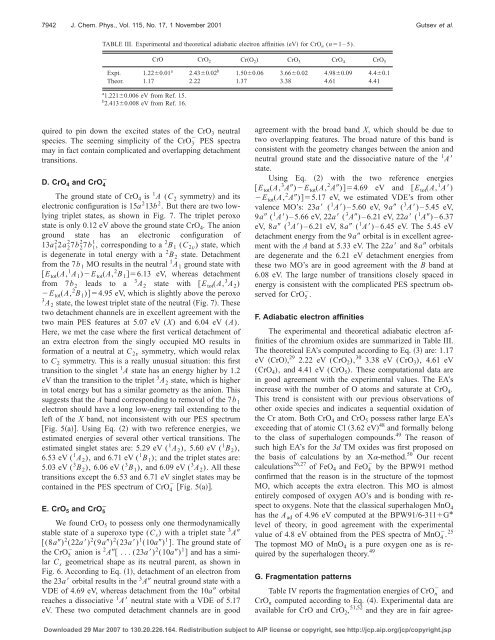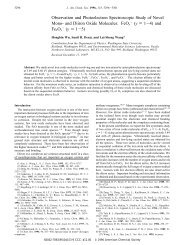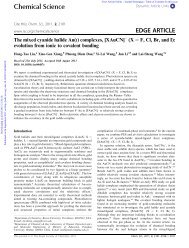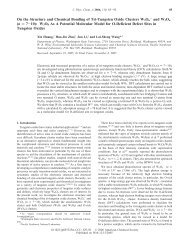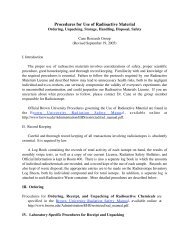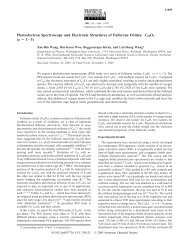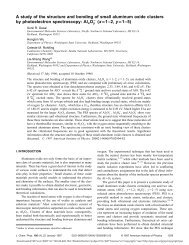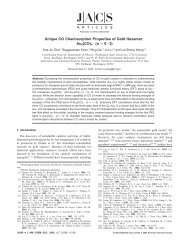Electronic structure of chromium oxides, CrOn - Washington State ...
Electronic structure of chromium oxides, CrOn - Washington State ...
Electronic structure of chromium oxides, CrOn - Washington State ...
You also want an ePaper? Increase the reach of your titles
YUMPU automatically turns print PDFs into web optimized ePapers that Google loves.
7942 J. Chem. Phys., Vol. 115, No. 17, 1 November 2001 Gutsev et al.TABLE III. Experimental and theoretical adiabatic electron affinities eV for CrO n (n1–5).CrO CrO 2 CrO 2 ) CrO 3 CrO 4 CrO 5Expt. 1.220.01 a 2.430.02 b 1.500.06 3.660.02 4.980.09 4.40.1Theor. 1.17 2.22 1.37 3.38 4.61 4.41a 1.2210.006 eV from Ref. 15.b 2.4130.008 eV from Ref. 16.quired to pin down the excited states <strong>of</strong> the CrO 3 neutralspecies. The seeming simplicity <strong>of</strong> the CrO 3 PES spectramay in fact contain complicated and overlapping detachmenttransitions.D. CrO 4 and CrO 4ÀThe ground state <strong>of</strong> CrO 4 is 1 A (C 2 symmetry and itselectronic configuration is 15a 2 13b 2 . But there are two lowlyingtriplet states, as shown in Fig. 7. The triplet peroxostate is only 0.12 eV above the ground state CrO 4 . The anionground state has an electronic configuration <strong>of</strong>13a 1 2 2a 2 2 7b 2 2 7b 1 1 , corresponding to a 2 B 1 (C 2v ) state, whichis degenerate in total energy with a 2 B 2 state. Detachmentfrom the 7b 1 MO results in the neutral 1 A 1 ground state withE tot (A, 1 A 1 )E tot (A, 2 B 1 6.13 eV, whereas detachmentfrom 7b 2 leads to a 3 A 2 state with E tot (A, 3 A 2 )E tot (A, 2 B 1 )4.95 eV, which is slightly above the peroxo3 A 2 state, the lowest triplet state <strong>of</strong> the neutral Fig. 7. Thesetwo detachment channels are in excellent agreement with thetwo main PES features at 5.07 eV (X) and 6.04 eV (A).Here, we met the case where the first vertical detachment <strong>of</strong>an extra electron from the singly occupied MO results information <strong>of</strong> a neutral at C 2v symmetry, which would relaxto C 2 symmetry. This is a really unusual situation: this firsttransition to the singlet 1 A state has an energy higher by 1.2eV than the transition to the triplet 3 A 2 state, which is higherin total energy but has a similar geometry as the anion. Thissuggests that the A band corresponding to removal <strong>of</strong> the 7b 1electron should have a long low-energy tail extending to theleft <strong>of</strong> the X band, not inconsistent with our PES spectrumFig. 5a. Using Eq. 2 with two reference energies, weestimated energies <strong>of</strong> several other vertical transitions. Theestimated singlet states are: 5.29 eV ( 1 A 2 ), 5.60 eV ( 1 B 2 ),6.53 eV ( 1 A 2 ), and 6.71 eV ( 1 B 1 ); and the triplet states are:5.03 eV ( 3 B 2 ), 6.06 eV ( 3 B 1 ), and 6.09 eV ( 3 A 2 ). All thesetransitions except the 6.53 and 6.71 eV singlet states may becontained in the PES spectrum <strong>of</strong> CrO 4 Fig. 5a.E. CrO 5 and CrO 5ÀWe found CrO 5 to possess only one thermodynamicallystable state <strong>of</strong> a superoxo type (C s ) with a triplet state 3 A(8a) 2 (22a) 2 (9a) 2 (23a) 1 (10a) 1 . The ground state <strong>of</strong>the CrO 5 anion is 2 A ...(23a) 2 (10a) 1 and has a similarC s geometrical shape as its neutral parent, as shown inFig. 6. According to Eq. 1, detachment <strong>of</strong> an electron fromthe 23a orbital results in the 3 A neutral ground state with aVDE <strong>of</strong> 4.69 eV, whereas detachment from the 10a orbitalreaches a dissociative 1 A neutral state with a VDE <strong>of</strong> 5.17eV. These two computed detachment channels are in goodagreement with the broad band X, which should be due totwo overlapping features. The broad nature <strong>of</strong> this band isconsistent with the geometry changes between the anion andneutral ground state and the dissociative nature <strong>of</strong> the 1 Astate.Using Eq. 2 with the two reference energiesE tot (A, 3 A)E tot (A, 2 A)4.69 eV and E tot (A, 1 A)E tot (A, 2 A)5.17 eV, we estimated VDE’s from othervalence MO’s: 23a ( 1 A) – 5.60 eV, 9a ( 3 A) – 5.45 eV,9a ( 1 A) – 5.66 eV, 22a ( 3 A) – 6.21 eV, 22a ( 1 A) – 6.37eV, 8a ( 3 A) – 6.21 eV, 8a ( 1 A) – 6.45 eV. The 5.45 eVdetachment energy from the 9a orbital is in excellent agreementwith the A band at 5.33 eV. The 22a and 8a orbitalsare degenerate and the 6.21 eV detachment energies fromthese two MO’s are in good agreement with the B band at6.08 eV. The large number <strong>of</strong> transitions closely spaced inenergy is consistent with the complicated PES spectrum observedfor CrO 5 .F. Adiabatic electron affinitiesThe experimental and theoretical adiabatic electron affinities<strong>of</strong> the <strong>chromium</strong> <strong>oxides</strong> are summarized in Table III.The theoretical EA’s computed according to Eq. 3 are: 1.17eV CrO, 29 2.22 eV (CrO 2 ), 30 3.38 eV (CrO 3 ), 4.61 eV(CrO 4 ), and 4.41 eV (CrO 5 ). These computational data arein good agreement with the experimental values. The EA’sincrease with the number <strong>of</strong> O atoms and saturate at CrO 4 .This trend is consistent with our previous observations <strong>of</strong>other oxide species and indicates a sequential oxidation <strong>of</strong>the Cr atom. Both CrO 4 and CrO 5 possess rather large EA’sexceeding that <strong>of</strong> atomic Cl 3.62 eV 48 and formally belongto the class <strong>of</strong> superhalogen compounds. 49 The reason <strong>of</strong>such high EA’s for the 3d TM <strong>oxides</strong> was first proposed onthe basis <strong>of</strong> calculations by an X-method. 50 Our recentcalculations 26,27 <strong>of</strong> FeO 4 and FeO 4 by the BPW91 methodconfirmed that the reason is in the <strong>structure</strong> <strong>of</strong> the topmostMO, which accepts the extra electron. This MO is almostentirely composed <strong>of</strong> oxygen AO’s and is bonding with respectto oxygens. Note that the classical superhalogen MnO 4has the A ad <strong>of</strong> 4.96 eV computed at the BPW91/6-311G*level <strong>of</strong> theory, in good agreement with the experimentalvalue <strong>of</strong> 4.8 eV obtained from the PES spectra <strong>of</strong> MnO 4 . 25The topmost MO <strong>of</strong> MnO 4 is a pure oxygen one as is requiredby the superhalogen theory. 49G. Fragmentation patternsTable IV reports the fragmentation energies <strong>of</strong> CrO n andCrO n computed according to Eq. 4. Experimental data areavailable for CrO and CrO 2 , 51,52 and they are in fair agree-Downloaded 29 Mar 2007 to 130.20.226.164. Redistribution subject to AIP license or copyright, see http://jcp.aip.org/jcp/copyright.jsp


